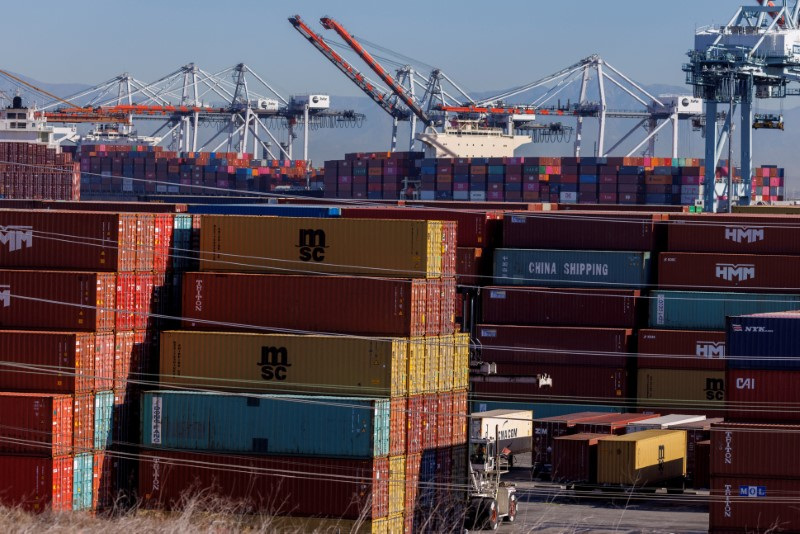By Lucia Mutikani
WASHINGTON (Reuters) -The U.S. trade deficit narrowed sharply in August as exports increased to a record high, suggesting trade could have little or no impact on economic growth in the third quarter.
The smaller-than-expected trade gap reported by the Commerce Department on Tuesday added to data on the labor market and consumer spending in suggesting that the economy remained on solid footing last quarter.
The economy's strength likely has no impact on expectations that the Federal Reserve will cut interest rates again next month. It, however, reinforced views that the U.S. central bank did not need to pursue another half-percentage point rate reduction. Economists at Goldman Sachs (NYSE:GS) maintained their forecast for gross domestic product to rise at a 3.2% annualized rate in the July-September quarter after the trade data.
"This report says that net trade supports GDP growth in August," said Carl Weinberg, chief economist at High Frequency Economics. "Putting together July and August figures suggests that net trade is flat so far in third quarter, making no significant addition or subtraction to GDP growth so far."The trade gap contracted 10.8% to $70.4 billion, the smallest in five months, from a revised $78.9 billion in July, the Commerce Department's Bureau of Economic Analysis said.
Economists polled by Reuters had forecast the trade deficit would narrow to $70.6 billion from the previously reported $78.8 billion in July.
Exports increased 2.0% to a record $271.8 billion. Goods exports surged 2.5% to $179.4 billion, the highest level since September 2022. They were boosted by a $1.7 billion rise in capital goods to a record high, mostly reflecting telecommunications equipment, civilian aircraft, computer accessories as well as other industrial machinery.
But exports of semiconductors fell.
Consumer goods exports increased $1.0 billion, lifted by pharmaceutical preparations. Exports of industrial supplies and materials increased as a $1.1 billion drop in crude oil was more than offset by a $1.5 billion rise in nonmonetary gold.
Automotive vehicles, parts and engines increased, driven by passenger car exports. Non-petroleum exports were the highest on record, as were those of other goods.
Exports of services increased $0.9 billion to an all-time high of $92.3 billion amid rises in travel as well as government goods and services. But exports of transport services fell.
Imports decreased 0.9% to $342.2 billion. Goods imports dropped 1.4% to $274.3 billion, pulled down by a $3.9 billion decline in industrial supplies and materials as well as a $1.2 billion decrease in nonmonetary gold.
Crude oil imports fell $1.0 billion. That reflected lower prices as well as quantities. Imported crude oil prices averaged $74.28 per barrel in August compared with $75.96 in July.
Motor vehicles, parts and engines imports decreased $1.3 billion, weighed down by passenger cars. But imports of other goods were the highest since December 2021. Goods imports had surged in the prior months, likely as businesses rushed to bring in shipments in anticipation of higher tariffs as well as a strike by dockworkers last week, which lasted only three days.
Stocks on Wall Street traded higher. The dollar slipped against a basket of currencies. U.S. Treasury yields rose.
STRONG DOMESTIC DEMAND
With domestic demand still strong despite 525 basis points worth of rate hikes from the Fed in 2022 and 2023, the decline in goods imports is likely to be temporary. The central bank launched its policy easing cycle last month, cutting its benchmark overnight interest rate by 50 basis points to the 4.75%-to-5.00% range, its first rate reduction since 2020.
"The resolution of the dockworkers strike earlier this month ensures supply chain disruptions would be minimal and removes a key risk to trade outlook," said Matthew Martin, senior U.S. economist at Oxford Economics. "Depleted inventories and resilient consumer demand indicate the drop in imports is unlikely to be sustained."
Imports of services increased $0.7 billion to an all-time high of $67.9 billion amid gains in travel and charges for the use of intellectual property. But imports of transport services declined.
When adjusted for inflation, the goods trade deficit declined 8.9% to $88.6 billion. The average of the so-called real goods trade deficit for July and August roughly equals the average for the second quarter. Trade has subtracted from gross domestic product for two straight quarters. The economy grew at a 3.0% pace in the April-June quarter.
The politically sensitive goods trade deficit with China narrowed $2.6 billion to $24.7 billion, with exports rising and imports decreasing. The goods trade gap with Canada also contracted, but widened with Mexico.

Economists perceived the rise in exports as unsustainable.
"The risks to global demand are tilted to the downside, as China's economy has yet to meaningfully stabilize and growth across the eurozone is showing some signs of fragility," said Nicole Cervi, an economist at Wells Fargo (NYSE:WFC). "On the flip side, domestic demand is poised to remain firm amid solid personal income growth and a strong dollar. Taken together, we look for trade to be a modest drag on real GDP growth throughout 2025."